 Sign In
Sign InThe #1 Free Blog Title Analyzer ®
Write Click-Worthy Blog Titles That Drive More Traffic


Get the FREE Headline Studio WordPress Plugin. Connect it now.
What Is A Blog Post Title Analyzer?
A blog post title analyzer is a tool or software designed to evaluate the effectiveness of a blog post title. Its primary purpose is to provide insights and suggestions to help writers create more compelling, engaging, and SEO-friendly titles for their blog posts.
Why Is A Good Blog Title Important?
A good blog title is important for several reasons, as it serves functions that contribute to the overall success and effectiveness of your blog:
- Attracts Attention
- Sets Expectations
- Improves Search Engine Visibility
- Encourages Click-Throughs
- Enhances Shareability
- Builds Brand Identity
- Supports SEO
- Differentiates Your Content
- Increases Readability
A good blog title is a critical element of your content strategy. It not only serves as a gateway to your blog but also plays a key role in attracting, engaging, and retaining your audience from search engines and other online platforms.

Tips For Writing A Killer Blog Title
A good blog title should make someone click and want to learn/read more. This is easier said than done, so here are some tips to write a blog title that people will want to read.
Incorporate Relevant Keywords
Incorporating relevant keywords can boost your blog title and draw more traffic to your blog post. Before you start writing your titles, you should research keywords that will represent your blog post well.
Once you find a good keyword that will help you rank on Google, be sure to place it at the beginning of your title, instead of burying it within the title or tacking it on the end.
For example, let’s say your keyword is Black Friday. Instead of titling your blog post “How You Can Save Money On Black Friday”, try “Black Friday Spending Habits That Will Save You Money”. Doing so will help your title rank higher on Google, and will improve your SEO.
Research Your Keyword
Before you start writing, conduct keyword research to identify terms and phrases that are relevant to your blog topic. Use tools like Google Keyword Planner, SEMrush, or Ahrefs to discover keywords that have a good search volume and are relevant to your niche.
Add Emotional Appeal
No one wants to read a boring blog post. One of the best ways to combat this is to add some emotional appeal to your writing, keeping users engaged. This all starts with writing a captivating blog title and making it appeal to your readers.
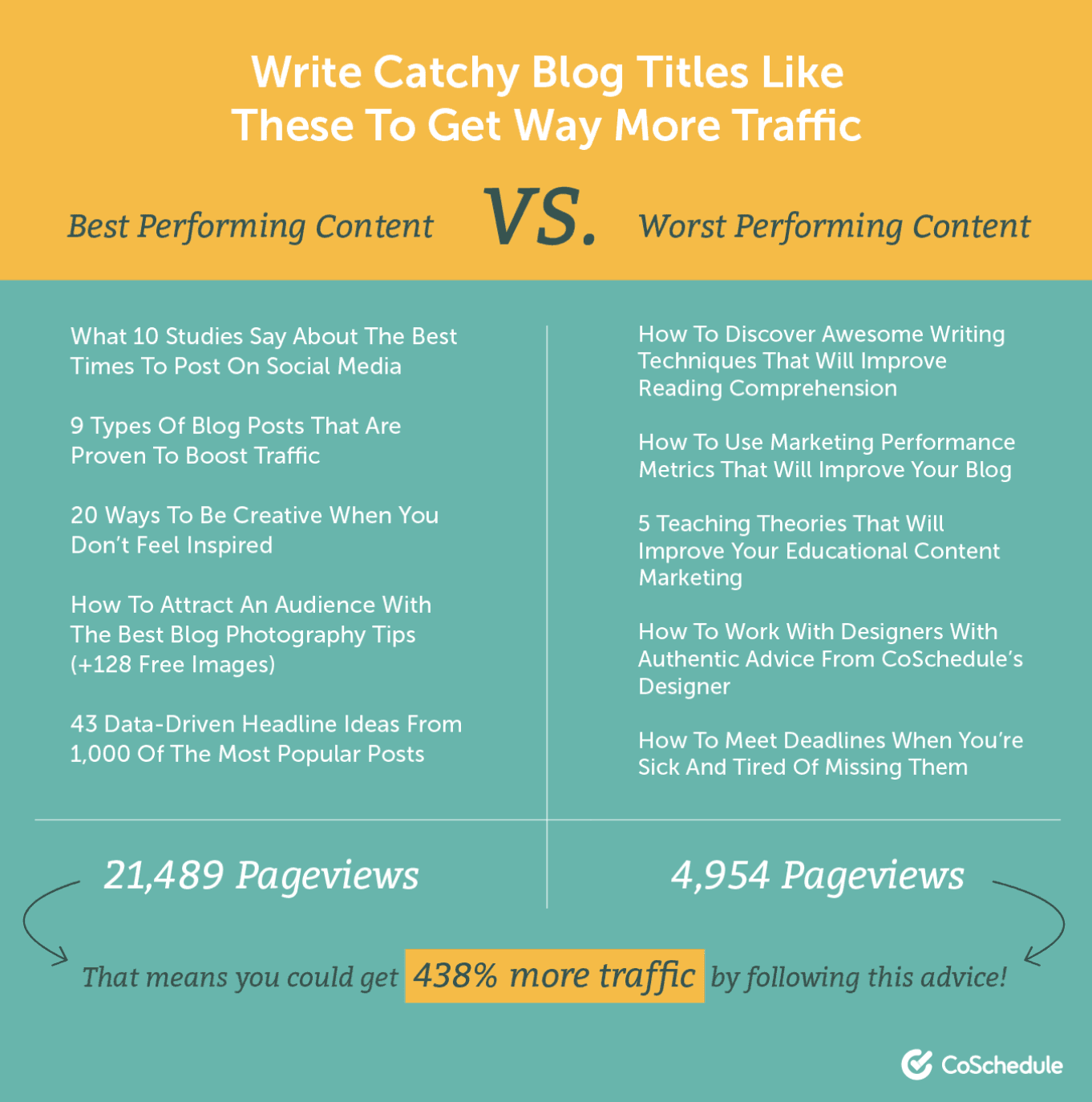
Keep It Compelling and Clickable
Although the saying “don’t judge a book by its cover” is true, we can admit it, a cover or title is that first initial impression we need to propel us to read something. The same thing goes for blog titles.
Sure, maybe a blog post with a boring title will still be worth the read, and can still contain valuable content. However, it’s hard to come across a boring-looking post and want to read it.
This is why you need an eye-catching, keyword-friendly, exciting title that entices readers to want to click on your blog specifically. This is easier said than done, and it can be hard to come up with creative, unique blog titles that will convert a viewer into a reader.
Optimize Length for Readability and Search Engine
Keep your title concise and within the recommended length for search engine displays (typically around 50-60 characters). This ensures that your entire title is visible in search results, and it’s straightforward and will show exactly what the reader will benefit from if they click in and read.
How To Use A Blog Post Analyzer
CoSchedule’s Blog Post Analyzer is easy to use and elevates your titles so they’re sure to attract readers and drive traffic. Let’s go over how you can use a blog post title analyzer.
Step 1: Write Out Blog Title Options
Creating titles might take some brainstorming, so it’s definitely worth writing a few options down, and weeding them out from there. You can also use our Free Blog Title Generator to easily come up with great title options.
Something I like to do is mix and match my titles. After I create a few options, I can take the first half of one title and combine it with the second half of another title. This ends up creating the best title option, and it’s fun to see the potential combinations.
Step 2: Analyze Your Title With Blog Title Analyzer
Once you’ve narrowed down some of your favorite titles, you can analyze them in order to see which one scores the best. These scores will take SEO, readability, and more into consideration so it can help you write the best-ranking blog title.
Step 3: Optimize Your Title In Headline Studio
After you analyze your blog titles, you can optimize them in Headline Studio to see your score and get an in-depth overview of how you can improve your blog title so the right audience sees it. 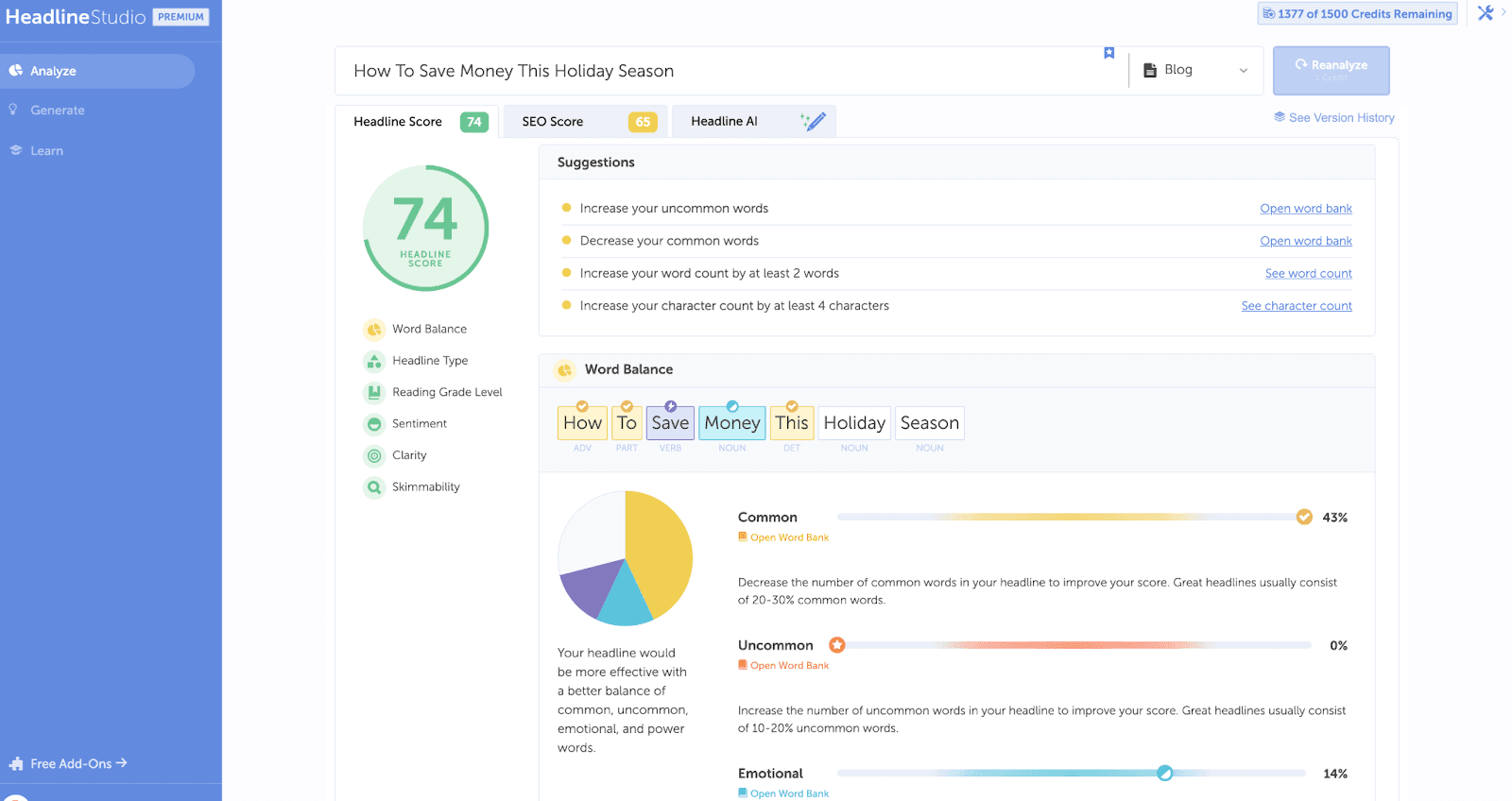
How To Optimize Your Blog Title For SEO
Optimizing your blog title for SEO is crucial for increasing your content’s visibility in search engine results. Let’s go over some tips on how you can effectively optimize your blog title.
Compare Against Top Ranking Blogs In Search
Comparing your blog title against top-ranking blogs in search involves analyzing several factors to ensure your title is competitive and likely to perform well. Here are some ways you can compare your blog titles:
- Review Top Performing Blog Titles on Google
- Understand Your Target Keywords
- Analyze Top Ranking Blogs
- Evaluate Title Structure
- Check Title Length
- Review Meta Descriptions
- Understand User Intent
- Keyword Placement
- Optimize for Click-Through Rate (CTR)
- Monitor Performance
Remember that SEO is an ongoing process, and staying updated with industry trends and algorithm changes is crucial. Regularly revisit and optimize your blog titles based on performance and evolving search trends.
Popular Tools To Analyze Your Blog Title
Let’s go over some of the best tools for blog title analysis.
CoSchedule’s Headline Analyzer
Headline Analyzer is a free tool that lets you analyze your YouTube title, Blog title, Email title, Podcast title, TikTok, and Instagram captions. All you have to do is select from the menu drop-down to see which category best fits, type in your headline options, and receive a score from Headline Studio.

Once you analyze your headline, you can see a comprehensive list of how your headline is ranked, and ways you can improve your score for better SEO results.
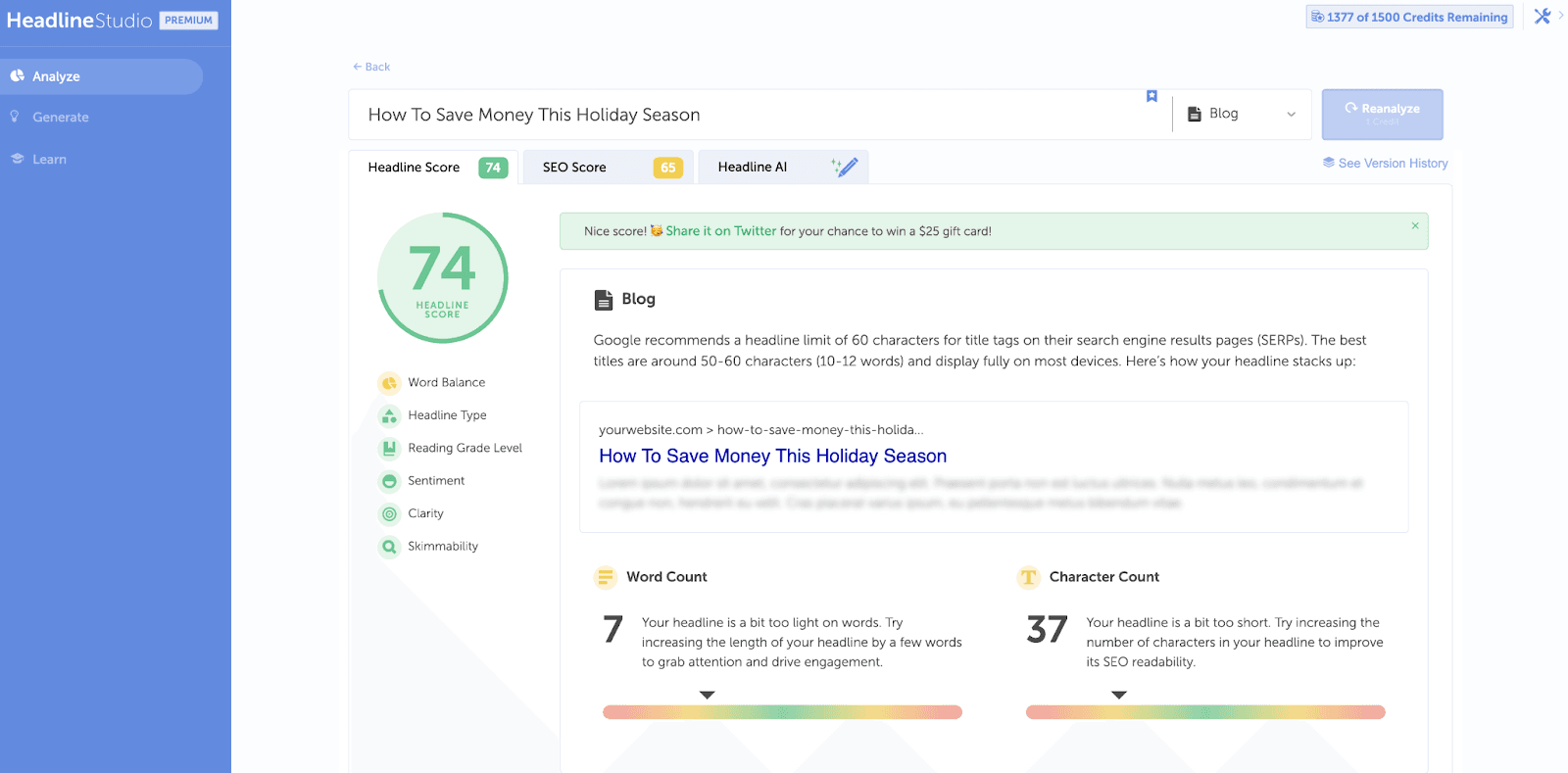
You can also try out Headline AI! Headline AI provides pre-built prompts for you, so you don’t have to know which questions to ask to get the best results. Use the AI prompts to generate ideas, get feedback in real-time, and optimize your headlines for maximum engage
MonsterInsights
MonsterInsights is a Google Analytics plugin for WordPress that provides several features. Among them is a free headline analyzer tool. This tool helps users create SEO-friendly headlines to boost site traffic and improve search result rankings.
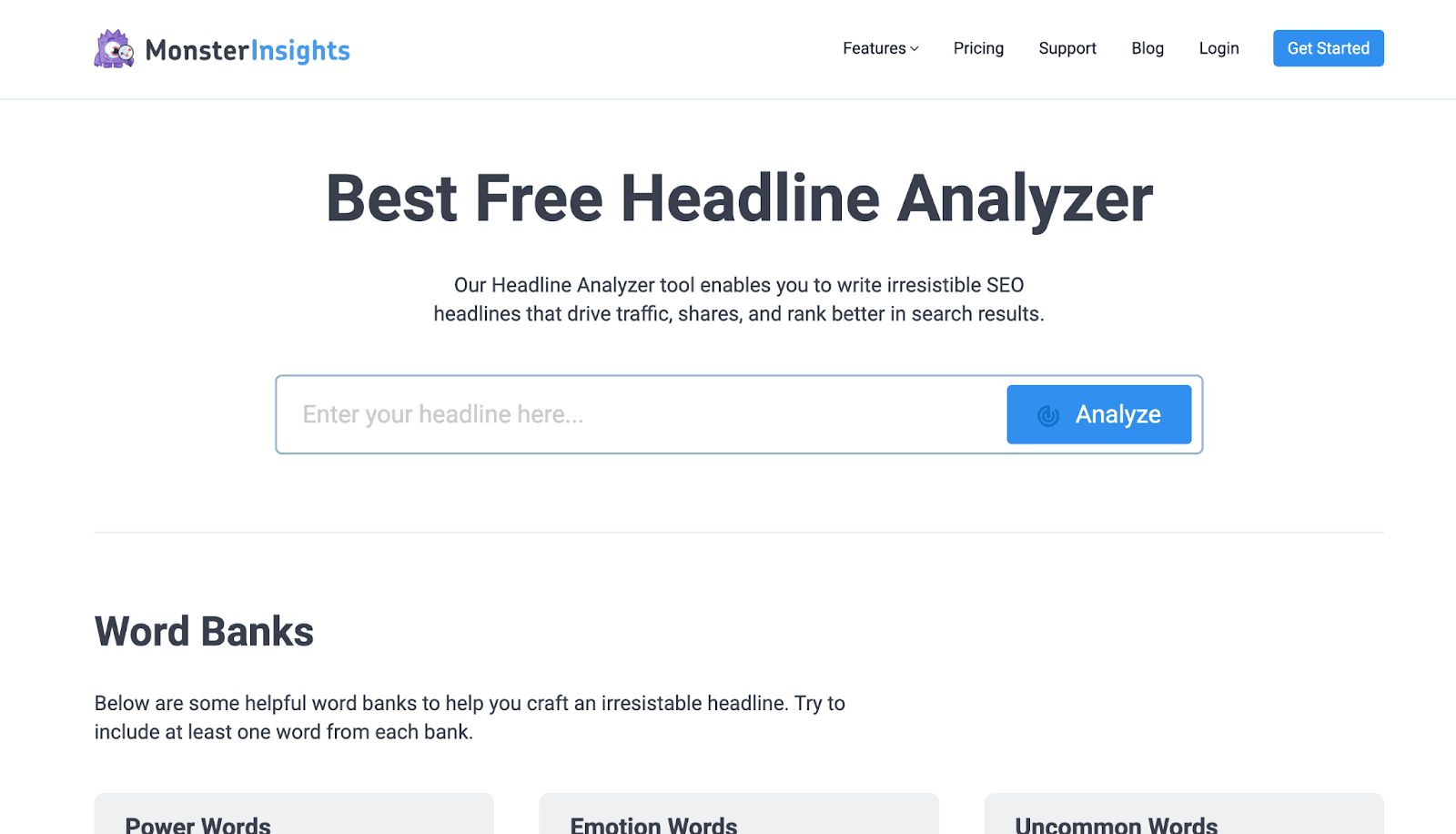
The tool also provides a list of power words, emotion words, and uncommon words to assist in crafting compelling headlines.
AIOSEO
AIOSEO headline analyzer is a free tool designed to help users create effective SEO headlines that can boost traffic, shares, and search rankings. The tool works by providing feedback on submitted headlines and suggesting improvements.

The website advises using powerful words, maintaining a balance of different types of words, conveying the right sentiment, keeping the headline to six words or fewer, and ensuring the character count is under 60 for the most effective headlines.
IsItWP
The IsItWP headline analyzer is a tool that helps assess the SEO effectiveness of a title and provides feedback on how to improve it. The tool analyzes various elements of the title, including word balance, word count, use of power words, emotional words, and the sentiment triggered by the title.
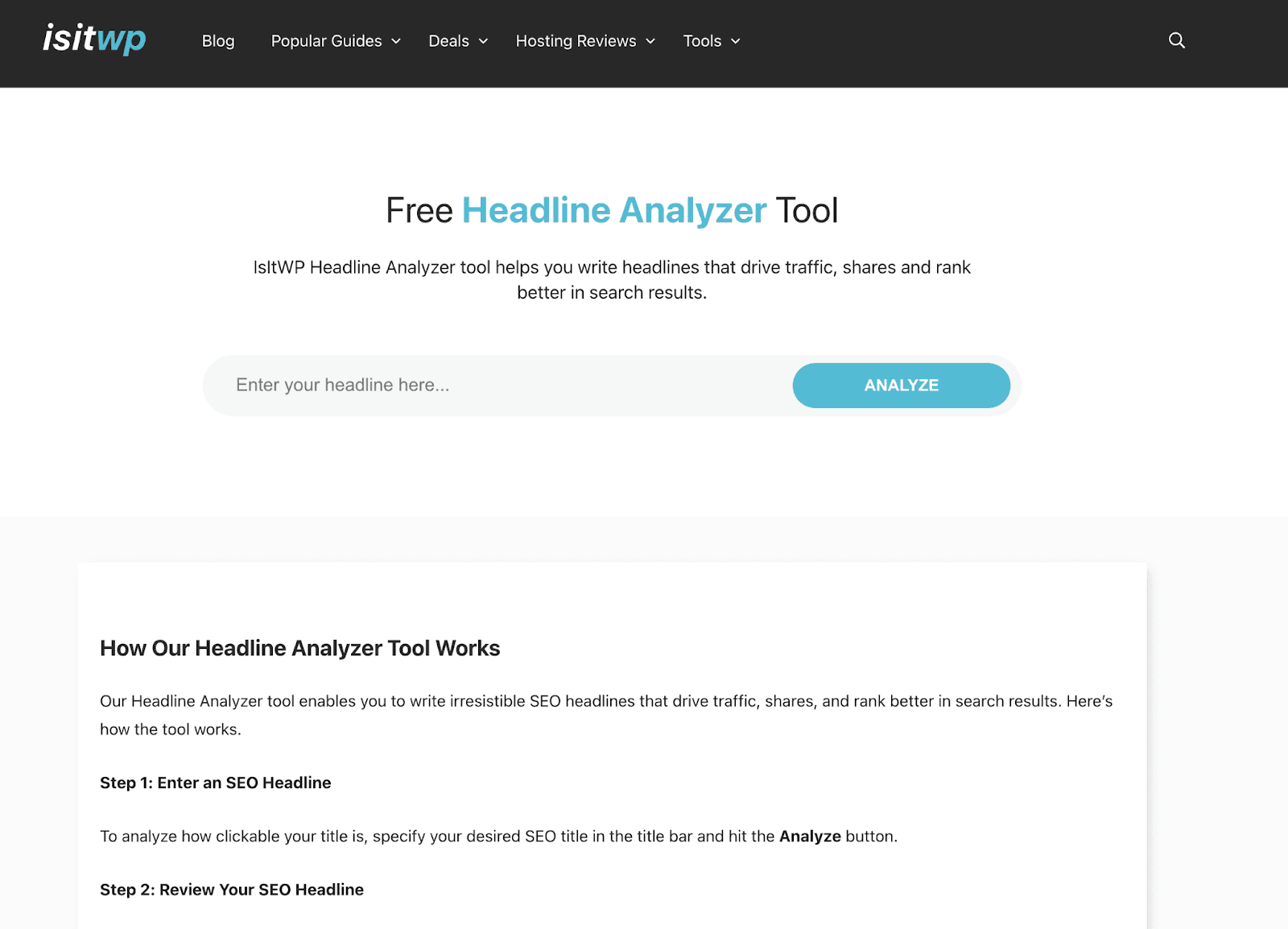
By following the tool’s recommendations, users can optimize their headlines to drive more traffic and improve their SEO rankings.
Capitalize My Title
Capitalize My Title is a versatile resource for writers, editors, and publishers. Among its offerings is a headline analyzer tool, which assists users in crafting effective, SEO-friendly headlines for their content.
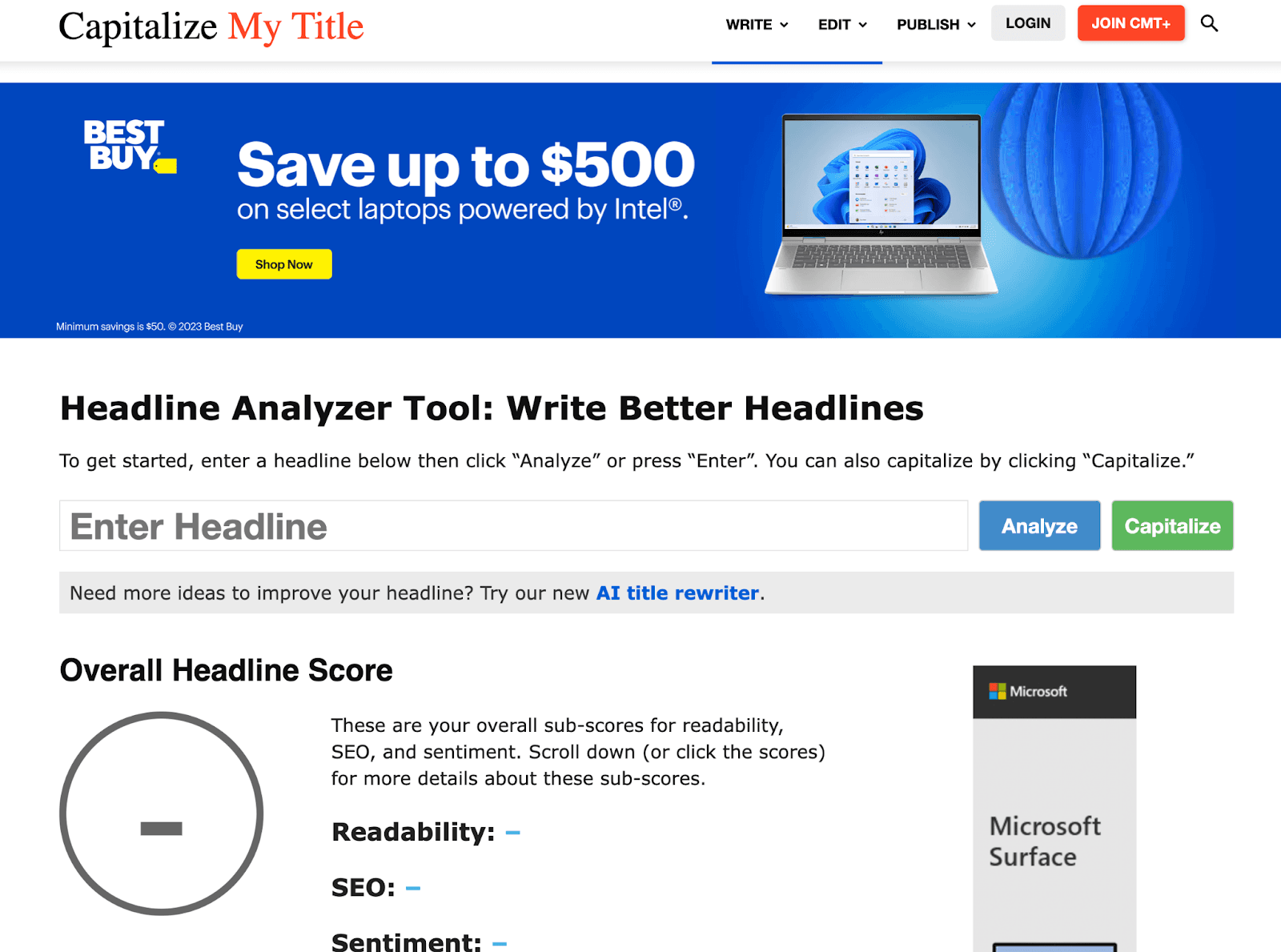
This tool is complemented by a variety of other resources, including a title capitalization & title case converter tool, an online word counter, and an online grammar checker.
Frequently Asked Questions
What Is A Good Score On Headline Analyzer?
Any score within the green-colored zone is an indicator of a good blog title. So, scoring 70 and higher means you’re on the right track to writing a great blog title. The scores range from 1-100, so the closer to 100, the better!
What Is The Ideal Length Of A Blog Title?
The ideal length of a blog title can vary depending on different factors, but a good practice is to aim for around 50-60 characters in length. This length allows for effective communication, ensures visibility in search engine results, and is generally well-received by users.
What Are Good Blog Title Examples?
“Unlocking SEO Secrets: A Guide to Crafting Irresistible Blog Titles”
This title combines the intrigue of uncovering secrets with the promise of valuable information on SEO and crafting irresistible blog titles. It suggests that the reader will gain access to insider knowledge, making it compelling and likely to attract those interested in improving their blogging skills.
“Mastering the Art of Click-Worthy Blog Titles: A Comprehensive How-To Guide”
Why: This title communicates a sense of mastery and expertise, indicating that the reader will gain comprehensive knowledge on creating click-worthy blog titles. The inclusion of “How-To Guide” suggests practical insights, making it appealing to individuals seeking actionable advice.
“Keyword Magic: Transforming Your Blog Titles for Maximum Traffic”
Why: Incorporating the term “Keyword Magic” adds a touch of mystique, implying that the reader will learn a powerful technique for enhancing their blog titles. The promise of transforming titles for maximum traffic is attractive to anyone looking to boost their blog’s visibility and reach a larger audience.
How Important Are Blog Titles For SEO?
Blog titles are vital for SEO. A good title will drive clicks and traffic to your blog post, website, and potentially your products. It’s like a funnel, we want them to make that initial click, and we hope they’ll like it so much that they’ll poke around in other areas of our website.
Explore More Headline Analyzers
Want to write even more engaging content? Explore additional content analyzers to perfect your blog titles, social media captions, email subject lines, and more.
- Headline Analyzer: Discover the power of the #1 headline analyzer. Write headlines that drive traffic, shares, and search results.
- Email Subject Line Analyzer: Use the best free email subject line analyzer to increase your open rates and turn prospects into leads.
- YouTube Title Analyzer: Write titles that reel in traffic, prompt clicks, and pique your viewer’s curiosity.
- TikTok Caption Analyzer: Write attention-grabbing captions that resonate with your audience, increase shares, and maximize reach.
- Instagram Caption Analyzer: Write captivating captions that boost engagement, enhance brand awareness, and drive results.
- Podcast Title Analyzer: Write captivating titles that grab attention, attract more listeners, and maximize your podcast’s impact.